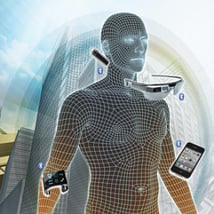Posted by Ron Tozaki, October 27, 2015
Does your product need to be tested for SAR?
 What is SAR?
What is SAR?
Specific Absorption Rate (SAR) refers to the amount of radio frequency electromagnetic field absorbed by the body while using a wireless device. SAR is defined as the power absorbed per mass of tissue and is expressed in units of watts per kilogram (W/Kg). SAR is typically measured over a small sample volume (1 gram or 10 grams). The SAR limit is a measure of the electric and magnetic field strength and power density for a given transmitter over its operating frequency range. In the US, SAR limit for FCC/IC is 1.6 W/Kg over a 1g sample and in Europe, the SAR limit for CE is 2.0 W/Kg for a 10g sample. Any portable products require SAR testing and reports.
Does your device require SAR testing?
Knowing the answer to this question at the beginning of a project can prevent unpleasant surprises and can reduce certification time. Unfavorable SAR test results can require a design change that can negatively impact project cost and schedule. This blog covers high level details and requirements for SAR testing. It is highly recommended to check with your compliance team on your product’s specific SAR requirements.
The FCC classifies products as fixed, mobile, or portable depending on how they are installed and used.
- Fixed Products: Fixed products are permanently located with an antenna affixed to a structure so that it cannot be easily relocated.
- Mobile Products: Mobile as the name implies, can be moved from one location to another and possibly be used in close proximity to the body.
- Portable Products: These are the same as mobile products in description, but distinction is the separation distance. Mobile products are used 20 cm or more away from the body, whereas portable products are used less than 20 cm from the body.
The FCC and other federal governmental agencies around the world require all wireless devices to be evaluated to meet the RF exposure limits set forth in the governmental SAR regulations. For Wi-Fi, the FCC has determined that high frequency radio waves in the 2.4 GHz and 5.0 GHz bands for use in Wi-Fi-type applications do not pose a hazard at distances greater than 20 cm.
Wi-Fi devices used in close proximity to the body fall under the portable products category. It is important to understand the steps required when designing such devices.
How is SAR tested?
 The most generally accepted method for measuring SAR values is the direct method SAR test. This method utilizes a model called a “SAM phantom” to simulate the human head and a “flat phantom” to simulate the human body. SAM stands for Specific Anthropomorphic Mannequin. With this method, wireless devices are tested at the highest certified power level in laboratory conditions utilizing a SAR test system with a robot. A probe is mounted on the robotic arm to measure the RF fields transmitted into a calibrated tissue simulant. Please refer to the KDB publication for details, requirements, and exemptions.
The most generally accepted method for measuring SAR values is the direct method SAR test. This method utilizes a model called a “SAM phantom” to simulate the human head and a “flat phantom” to simulate the human body. SAM stands for Specific Anthropomorphic Mannequin. With this method, wireless devices are tested at the highest certified power level in laboratory conditions utilizing a SAR test system with a robot. A probe is mounted on the robotic arm to measure the RF fields transmitted into a calibrated tissue simulant. Please refer to the KDB publication for details, requirements, and exemptions.
Silex Can Help You!
At Silex Technology America we have the technical expertise needed to meet the SAR certification needs of our customers. We have successfully obtained FCC/IC and Europe/CE SAR certifications for multiple commercially shipping products in the market. We can help you attain a portable modular certification for your specific application and antennas. Please contact us sales@silexamerica.com for your inquiries and how Silex can help your devices be in compliance with the latest regulations.
References:
Please refer to the following FCC KDB #447498v0502 (Feb 07, 2014) General RF Exposure Guidance at:
https://apps.fcc.gov/oetcf/kdb/forms/FTSSearchResultPage.cfm?switch=P&id=20676

%20_300dpi.jpg?width=300&height=300&name=AP-800AX(2000x2000)%20_300dpi.jpg)